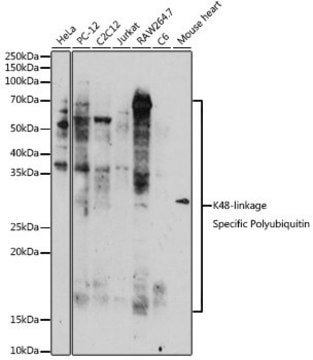05-1307
Anti-Ubiquitin Antibody, Lys48-Specific, clone Apu2, rabbit monoclonal
clone Apu2, from rabbit
Synonym(s):
Anti-HEL-S-50
About This Item
Recommended Products
biological source
rabbit
antibody form
purified antibody
antibody product type
primary antibodies
clone
Apu2, monoclonal
species reactivity
rabbit, mouse, human, rat
technique(s)
cell based assay: suitable
flow cytometry: suitable
immunocytochemistry: suitable
immunohistochemistry: suitable
immunoprecipitation (IP): suitable
western blot: suitable
isotype
IgG
UniProt accession no.
shipped in
wet ice
target post-translational modification
unmodified
Gene Information
human ... UBAP2(55833)
General description
Di-Ubiquitin (Lys48-linked) Recombinant Protein (17-10408)
In contrast, polyubiquitin chains linked through the Lys63 residue of ubiquitin (Ub) are associated with nonproteolytic functions such as signal transduction. Lys63-linked polyUb chains connect components of NFκB signaling in a highly regulated manner, and genetic evidence indicates the involvement of Lys63-linked Ub chains in stress response and DNA repair. Research in yeast has suggested Lys63-linked Ub chains stimulate endocytosis.
Specificity
Immunogen
Application
Ubiquitin (Lys 48-specific) staining of rat brain sections (left figure) or human breast carcinoma (right figure). Staining pattern detects axons of neurons in brain tissue but not surrounding glial cells, and breast tumor cell cytoplasm is strongly detected without nuclear involvement.
Immunocytochemistry:
Confocal IF analysis of NIH/3T3, HeLa, and A431 cells using anti-Ubiquitin (Lys48 specific) (Red). Actin filaments were labeled with AlexaFluor 488-Phalloidin (Green). Nuclear material is stained with DAPI (Blue).
Flow cytometry:
Flow cytometry analysis of Jurkat cells using Anti-ubiquitin Lys48-specific (#05-1307) (blue) and rabbit IgG control (red).
Immunoprecipitation:
Rabbit monoclonal anti-ubiquitin (Lys-48-specific), clone Apu2, precipitated ubiquitin-containing proteins from HeLa cell lysates.
Inhibition Assay:
Preincubation of anti-ubiquitin, Lys48-specific, with K48-multiubiquitin chains inhibited binding to HeLa cell lysate in Western blots.
Signaling
Ubiquitin & Ubiquitin Metabolism
Quality
A 1:1000-1:5000 dilution of this lot detected Lys-48 ubiquitin chains by Western blotting.
Target description
Physical form
Storage and Stability
For maximum recovery of product, centrifuge the vial prior to removing the cap.
Analysis Note
Lys48 polyubiquitin chains.
Disclaimer
Not finding the right product?
Try our Product Selector Tool.
recommended
Storage Class Code
12 - Non Combustible Liquids
WGK
WGK 1
Flash Point(F)
Not applicable
Flash Point(C)
Not applicable
Certificates of Analysis (COA)
Search for Certificates of Analysis (COA) by entering the products Lot/Batch Number. Lot and Batch Numbers can be found on a product’s label following the words ‘Lot’ or ‘Batch’.
Already Own This Product?
Find documentation for the products that you have recently purchased in the Document Library.
Customers Also Viewed
Our team of scientists has experience in all areas of research including Life Science, Material Science, Chemical Synthesis, Chromatography, Analytical and many others.
Contact Technical Service






